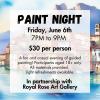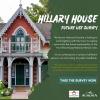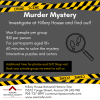Hunter, Richard (2014) Transcript
November 21st 2014
Transcription: Richard Hunter (RH), interviewed by Heba Shahaed (HS)
HS: Hi my name is Heba, and I am here interviewing Richard Hunter at the Hillary House and he is going to be telling me about Lloyd Chadburn.
RH: Okay, thank you very much Heba. This is actually a story that I told to the PROBUS Club, I’ve been a member of the PROBUS Club for a number of years, and I told this in November 2007, very close to Remembrance Day. So I think it’s rather appropriate that we are very close to Remembrance Day on this date, and so I thought I’d tell the story. And I’ve lived in Aurora, by the way, for 25 years, but my history goes way back. And I’d like to tell you about Lloyd, he was a famous Canadian World War Two fighter pilot and his home was right here in Aurora. So that’s what I’m going to talk about.
Now, going back, in 1935 I lived on Renley Avenue in North Toronto just north of Laurence and Yonge. I was 5 years old at that time, quite a difference today. My mother’s very good friend, Florence Chadburn, phoned my mum and asked her if her son Lloyd could stay with us for when he went to Northern Vocational School on Mount Pleasant Avenue. Florence lived in Aurora at that time and was having our family, and having met our family when we both lived in Oshawa before I was born. So it was in the middle of the Depression and we needed the money and my mom was the housekeeper for Dr. Graham, a family doctor in North Toronto. So we quickly said “yes, yes we’ll gladly take care of Lloyd.”
He was an only child, and he was the son of Lorenzo Chadburn, who was the only Ford dealer in Oshawa, which was a General Motors town. After Lorenzo died, Mrs. Chadburn moved to Aurora and she met and married an Imperial Oil dealer, Frank Allen. And there’s still the Esso station down in the south end of town that he had. She obviously like the car business, I guess. Now she was also quite well off from the proceeds from her husband’s estate and soon purchased the elegant Chateau, which is still there on the west side of Yonge, south of Wellington, up on the hill. I think it’s a half way house or something today. She turned this place into an elegant tourist home back in 1935. Back in those days there was no such thing as hotels, tourist homes were the places you stayed. She turned this thing into a beautiful spot.
Since there were no technical schools in Aurora, and Lloyd was more interested in things mechanical rather than academic, Florence wanted to send him to Northern Vocational to learn a trade. Which is kind of similar to what a lot of parent’s are saying to their kids today, before they go into high school or wherever they go from there.
After he moved in with us, he really became my big brother. And Lloyd being an only child, and I would day somewhat spoiled in retrospect, and also being the son of the only Ford dealer in Oshawa, he even had his own Ford Roadster Convertible. Can you imagine? Aside from the car, now Lloyd was quite an All-Canadian teenager of 16. He, I remember as if it was yesterday, he had wavy blonde hair, blue eyes, and he loved to have fun you know. He was, he was quite a guy. He’d wrap a tie around his forehead when he went out in the car to keep his long blonde hair back and he’d sit me in the front seat, there’s little Dick, Richard, here and he would tear around North Toronto and I’m looking up at him, “Wow! This guy’s really something.” We used to drive over to Bayview Avenue where it ended at Laurence, but Bayview Avenue didn’t even have a bridge back in those days so we had to turn around and come back to Renley Avenue. But what a guy to have as a buddy for a six-year-old, it was wonderful.
When Lloyd was in Northern he joined the Shooting Club. He became the top marksman in the Toronto High School group. He had an uncanny ability to lead the target, anticipate where it was going, and then hit it square on. It was quite interesting because that aptitude served him no doubt, very well, in downing German planes just four to five years later when he was sent overseas and was flying over the North Sea in Europe.
Lloyd graduated from Northern and he took a job as a bank teller, kinda dull for a guy like that. And then, just before the war he worked as a car jockey for General Motors, shuttling cars back and forth between Toronto and Oshawa. Then Lloyd joined the Royal Canadian Air Force, I think it was the end of 1939 or early 1940. War had broken out September the 3rd, 1939, when the Nazis invaded Poland back then. And Lloyd graduated in the spring of 1940 at the Rockcliffe Uplands Training School. That was a big training school for, early training school, but later they got a whole bunch of them across Canada.
He was sent overseas almost immediately because things were rough in those days in England. England was desperate as the Germans moved all the way through Europe and they conquered everything in Europe, right up to the English Channel. So they were sitting face to face, ready to invade England. He was soon stationed up at a remote airfield up in the Orkney Islands. I don’t know whether you’re familiar with the geography of that area, but the Orkney Islands are islands that sit in the North Sea, off the north-east coast of Scotland. Right up where Europe comes around and then all the German ships used to come around through there. And he was flying Hawker Hurricane Fighter Planes on the North Sea Patrol; very similar plane, but not as good as the Spitfire, which he eventually flew.
It was during this posting that his name, for the first time, appeared in Canadian newspapers. One of the first newspaper reports described how Lloyd sank a German e-boat, which is like a torpedo boat, and he sank it in the English Channel. Well gosh, a Canadian guy over there, doing that, sinking a German- well that was pretty good. Then shortly after that, he really hit the big time, Lloyd was in the newspapers again after shooting up the Scharnhorst. The Scharnhorst was the largest German Battleship and it was coming down, you know, and invincible, coming down the English Channel. He shot it up, did a pretty good job on it.
So I became aware of Lloyd’s exploits and the newspaper articles, and at nine years of age I began to compile a scrapbook, I thought god, he’s my hero and I want to show it to him when he comes home, because he’s really really doing something. So I kept this throughout the war. I kept the book up to date from 1940 through to 1945, a year after his death. 1945 Florence Chadburn received the Croix de guerre and the Legion of Honour posthumously from the French government, and I got a picture of her getting that, and that’s in the scrapbook. Now in 1990, when I moved to Aurora, I donated the book to the museum in Aurora, and at that time the same building, that museum and that’s where the Cultural Centre is now, was where Lloyd went to public school. And Lester Pearson, by the way, went to Public School there, it’s a very famous building.
So continuing on, Lloyd and his squadron set a new record for kills, or planes that were shot down, as they flew cover over Dieppe. Dieppe was a famous All-Canadian raid that occurred in 1942, and were, the Allies were kinda testing out how strong the German defenses were in Europe at that time, in 1942. And he, he set a, they downed nine Messerschmitt 109’s in nine minutes, it was kind of a record, and I got the newspaper article from that. There used to be a weekend edition of the Toronto Star, and it was in colour and, and they did a visual look of Lloyd, and they told the story of how he and his guys downed nine of these German planes in nine minutes. It’s phenomenal. He got the distinguished flying cross for that, for what he did in Dieppe in that particular episode.
As the war unfolded Lloyd became increasingly famous as a Spitfire fighter pilot. That was la crème de la crème, that’s the top fighter that the Allies had then, beautiful plane. When I was in the Air Cadets at the end of the war, wanted to be the same as Lloyd after I got to be fourteen, all I wanted to do was to fly a Spitfire plane. But by the middle of 1943 he’d been decorated by the King at Buckingham Palace and he’d received the Distinguished Flying Cross, the Distinguished Service Order, plus bar, at the Palace. And the interesting thing was that the DSO is the second highest award for bravery in the British Empire, the top award is the Victoria Cross, but he got the DSO.
So he came back to Canada on a 30 day leave and I met him, he came over to our house in North Toronto and I couldn’t, I could not get over how this boy had aged so much. He looked tired and he acted like an older man, and to top it all off he even smoked a pipe. I guess that was the thing to look good or something in the World War Two days.
Now he returned to England, where he was given command of a whole bunch of squadrons: 402, 403, 416, RCAF squadrons, he was 21, 22 I guess by that time, as well as 118 RAF Spitfire Squadron. He and his boys flew fighter cover for the American Flying Fortresses Bombers. These were daylight bombers that flew over Europe and bombed the Germans. The Americans called him “The Angel” because of his well-disciplined fighter pilots, helped provide them safe passage during very risky daylight raids when the Germans could see them very clearly. But Lloyd and his guys, and I guess Lloyd did most of the work on the thing, developed a strategy of how to look for and how to hang around and get the Germans before they came down and got the American Flying Fortresses.
By this time he was a Wing Commander and he was only 23 years old. Now a Wing Commander in the army is like a Lieutenant Colonel, not bad for a 23 year old you know. He also had 14 enemy planes to his credit at that time, but he had a reputation of never being interested, only in the success of his squadron, not in his own kill score. If there was any doubt, he gave it to the other guy you know, but that’s the kind of guy he was. By this time his own crew, as well as other Allied fighters affectionately called Lloyd “Chad,” he was well known throughout the fighter pilot society.
Lloyd was brought back to Canada again in January, through the winter and into the early spring of 1944, when he assisted in the war effort, he was a hero by this time. And he helped getting, going around and promoting the sale of victory bonds through personal appearances as a Canadian war hero, and there were all kinds of newspaper pictures about that too.
Now he returned in England in May of 1944. About 3 weeks before D-Day, which was June the 6th, that’s the big Allied invasion of Europe, or of France, just across the Channel. And he was there to prepare his men for the imminent invasion of Europe. By this time he was the commander of the total Canadian Tactical Fire Wing for the invasion of Europe, which was quite a responsibility. But it was indicative of the esteem in which he was held. Despite his young age he was recognized as a brilliant leader and a superb strategist in air battle.
The invasion was on June 6th, 1944. Lloyd and his crew flew cover for the Allied troops, including thousands of Canadian soldiers going in off the landing barges, I don’t know if you’ve ever seen pictures of them, but they were coming in and sometimes the shells would hit in front and these poor troops would have to, they’d have to, the front of the landing barge would go down and the troops would have to go off, and sometimes over their head in water. And then they’d struggle through the water with all their gear on, they’d land on the beach and the Germans shot them up. But he was providing as much cover as he could.
So that was on June the 6th. June the 13th, seven days later, Lloyd and his squadron were flying in on low support formation over the beach-head area, keeping an eye on our troops. They were engulfed in heavy, low-hanging clouds, hard to see anything. Suddenly, another formation of Spitfires broke through the clouds, on a direct collision course with Lloyd’s group. Lloyd was struck head on in a mid air collision as the number four man from the other section, it was the City of Winnipeg’s squadron as a matter of fact, came out of a wisp of a cloud, slammed into Lloyd and he and Jack Clark, the pilot of the other plane, plummetted to the ground and they were killed as the plane struck the ground.
His death was a tremendous blow to the Canadian people, many others, and me. The Canadian and British fighter pilots, as well as the American bomber crews wept openly at the death of the Angel. As the Americans said in interviews, “the Angel was gone.” In late June 1944 a memorial service was held, right here in Aurora at Trinity Anglican Church, to which we still belong today. I attended as a heart broken 13 year old. I had the opportunity of meeting a number of members of Lloyd’s squadron who had flown with him, and it was apparent that they really loved this guy. He was adored. My scrapbook then closed, brokenhearted, my hero was gone. But it was reopened briefly in 1945, as I said earlier, when his mum got the Government of France Award for Lloyd posthumously, the Croix de guerre and the Legion of Honour. And Florence received these in Ottawa from the Governor General, along with another bar to his DSO.
So, everything went quiet and then, 45 years later, Eve and I moved up to Aurora, and so when we got up here Eve suggested that I donate my scrapbook to the museum, that would be a good thing to do because he was an Aurora boy and grew up here. So I took it over and, and I gave it to Jackie Stuart and the museum. And I guess some of the museum is still, all of the records are kept there, but it was kept over there at the Church Street Public School, where he went to school, which is now the Cultural Centre.
In July 1991 Jackie Stuart, the curator of the Aurora Museum, was phoned by a man called Andrew Cockshutt, of Cumbria, England, requesting information regarding Lloyd, who he claimed was his father. Since he requested a picture Jackie contacted me to ask for permission to send a copy of the picture that I had in my scrapbook of Lloyd. It was a big, full page, picture of my hero. It was sent, and lo-and-behold about, I guess it was a week or two later, I received a long-distance call from England about 7am on a Sunday morning. It was a tearful Andrew Cockshutt advising that he had received the picture and Lloyd was his father, and that he looked strikingly like his father. The telephone call began a long story of discovery and a close, personal relationship with Andrew and his wife Enid between myself and my wife Eve.
After many long letters from Andrew we learned the heartrending story of Lloyd’s romance, followed by his untimely death over the D-Day beach head, June of 1944. I have many of the details of the story in my files of the letters from Andrew, and frankly the story could provide the basis of an outstanding film or T.V. documentary, it would be a goodie. So here’s a short version of the story. Let’s move back to 1943. Okay, in the autumn of ’43, Lloyd was returning from a low-level mission over occupied France, with his aircraft pretty well shot up, and he had to make an emergency landing at the British base of Doverhart Region, Kent, which is in south-east England. After he landed, he met a very pretty WAF, Women’s Auxiliary Air-force is what it stands for, called Nan MacKay. They dated, they fell very much in love, and became lovers. One of their romantic liaisons was at Johnny Burkes Pub and Inn, just behind the Strand Palace Hotel in London, close to Trafalgar Square. Even I’ve stayed there many times in that hotel. It was here that Andrew, Lloyd’s son, was conceived close to Christmas in 1943.
Now as mentioned, Lloyd had returned from the last trip to Canada in May of 1944. He didn’t know that Nan was pregnant. Apparently he could not contact her due to a communications black-out prior to the invasion. There was a black out on all information about 2 or 3 weeks before the invasion. However, subsequent information revealed the real, the real total story. Upon his return from Canada in mid-May, prior to the D-Day invasion, Lloyd tried to phone Nan MacKay at Biggin Hill in south-east England, that’s where he met her. He was advised that Nan MacKay was on leave, well she was actually on her honeymoon, having married a Canadian Merchant Marine Captain. Lloyd was crushed to hear this information, he couldn’t believe it. He slumped into a very, very low period, all the time trying to get his Canadian wing ready in the next few weeks, for the all important D-Day invasion. On June the 13th Nan, the real Nan, was one of the WAFs on operation posting at Biggin Hill, posting locations od the Allied Aircraft’s and the Nazi aircrafts over the beachhead area. This was on June the 13th, the day he was killed. Over the RT system, the announcement system, came an ominous and sad voice, “Chad has bottomed, he’s been killed.” She was in shock, Nan was in shock. She was also 6 months pregnant with Lloyd’s child. Nan’s son was born, and he was named Nicholas MacKay on September 22nd 1944. Nan was not allowed to come home with her baby, girls did not have babies illegitimately in those days, she was not allowed to bring the baby home. So she ended up living in a church hostel in Liverpool and then after a year she had to give the baby up for adoption.
Subsequent to Lloyd’s death the truth came out. The day Lloyd called Nan at Biggin Hill she was on leave, the real Nan MacKay was on leave. There just happened to be another Nan MacKay as a WAF at Biggin Hill, and she was the one on the honeymoon leave with the Canadian Merchant Marine Captain. The real Nan MacKay was never contacted. So James Cockshutt, a Protestant Minister, became the adopted father of Nan’s baby, and the baby was renamed Andrew. Andrew was raised in Manchester, and later in Burrow on Furness in the Lake District. Nan MacKay herself, the real Nan McKay, had given James Cockshutt a Canadian newspaper clipping about Lloyd at the time of the adoption, back in 1945. After James died this was given to Andrew by his mother some 46 years later. That then lead Andrew to search for information about his father Lloyd Chadburn. That’s the reason for the call, the request for the picture, etcetera.
Andrew decided to come to Canada to try to find out his father’s roots, where he came from, what his family was. And in early 1992 Andrew and I, together, began the planning of a reunion of Lloyd’s 416 Squadron, as a means of meeting Lloyd’s old buddies, and also to meet the son of their cherished leader. It would also give him an opportunity to meet family and cousins that he was never before aware of. We organized this for Beacon Hall in Aurora, where Eve and I live. It was held on August the 8th, 1992. The turnout was fantastic, former buddies arrived from all over the world, from Texas, from Europe, from all over Canada. One 80 year old former wing man rode his motorcycle in from British Columbia, can you imagine? Then he met his cousin’s from Oshawa for the first time, because that’s where, that’s where my mom met Florence Chadburn in the first place, in Oshawa. The family at first had rejected Andrew as a phony, just trying to take advantage of Lloyd’s reputation. However after actually seeing him, and the remarkable resemblance to Lloyd, there were tears and there was lot’s of raw emotion. It was really, it was really something to see. And then Andrew got up and he gave his tearful account of what he had found out about his father and mother. Then there was a talk by a fellow called Jackie Rae, and you ladies, would not remember Jackie Rae but Jackie Rae was a, he was a close friend of Lloyd’s as one of his squadron members, but then after the war he became a CBC performer, and a producer, and he was a founder of of the, back in those days, back in the, that would be in the fifties I guess, of the famous Spitfire Big Band, really that was a big deal on TV. Lloyd had been Jackie’s best man when he was married in England during the war.
And he returned to England and then shortly there after Eve and I went over to England and we stayed with them at their home in Cumbria, in the Lake District. And then later, they had to come back to Canada again and they were celebrating Chadburn Memorial Day at Oshawa Airport on June the 12th 1994, it was 50 years after Lloyd’s death and Eve and I went there. Lloyd Chadburn was very well known in Oshawa, and I believe that the City of Oshawa has a Chadburn Day June the 13th, the day he was killed. The 151 Chadburn Oshawa Air Cadet Squadron is ranked as the best in the country. There’s also a wonderful museum display at the Oshawa Airport of pictures and artifacts of Lloyd’s short but dramatic life as a young Canadian airman.
So kinda summing this thing up, that’s the story. But the interesting thing to me as I reflect on Lloyd’s short life is the transformation of a rather typical, easy-going, Canadian kid; into a truly outstanding leader with a legacy of great leadership skills and courage. All within the space of four years, it’s quite amazing. And I said to myself, we grow them real good in our home and native land, Canada. Thanks for listening folks.
HS: Thank you so much.
Bonus information on Llyod:
http://www.chadburn.org/squadron-history/wing-commander-chadburn
http://www.constable.ca/caah/chadburn.htm




















